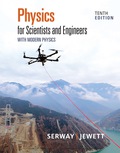
Concept explainers
(a) Does your bathroom mirror show you older or younger than you actually are? (b) Compute an order-of-magnitude estimate for the age difference based on data you specify.
(a)
Whether the bathroom mirror shows a person older or younger than the actual age of the person.
Answer to Problem 1P
The age shown by mirror is less than actual age that is mirror shows the person younger than the actual age.
Explanation of Solution
When rays strike on the face it reflects back and travel toward mirror and then bounce back in just very little second difference. Let consider two events, first when ray leaves the face and second when rays return to the face. Hence, between these two events the person age himself a very few second. Although this time is very less approximately few nanoseconds, but the light that travels between the person and the mirror and does not age at all. So the image in the mirror is actually younger than the person is by few nano-seconds. Hence the person will see him younger than actual age.
Conclusion:
Therefore, mirror shows the person younger than the actually age.
(b)
The order of magnitude estimate for the age difference.
Answer to Problem 1P
order of magnitude estimate for the age difference is
Explanation of Solution
Formula to calculate time travel by light is,
Here,
Assume distance from the mirror is
Substitute
Conclusion:
Therefore, order of magnitude estimate for the age difference is
Want to see more full solutions like this?
Chapter 35 Solutions
Physics for Scientists and Engineers with Modern Physics
- I need correct answer not chatgptarrow_forwardWhat is the resistance (in (2) of a 27.5 m long piece of 17 gauge copper wire having a 1.150 mm diameter? 0.445 ΧΩarrow_forwardFind the ratio of the diameter of silver to iron wire, if they have the same resistance per unit length (as they might in household wiring). d. Ag dFe = 2.47 ×arrow_forward
- Find the ratio of the diameter of silver to iron wire, if they have the same resistance per unit length (as they might in household wiring). d Ag = 2.51 dFe ×arrow_forwardShow that the units 1 v2/Q = 1 W, as implied by the equation P = V²/R. Starting with the equation P = V²/R, we can get an expression for a watt in terms of voltage and resistance. The units for voltage, V, are equivalent to [? v2 v2 A, are equivalent to J/C ✓ X . Therefore, 1 = 1 = 1 A V1 J/s Ω V-A X = 1 W. . The units for resistance, Q, are equivalent to ? The units for current,arrow_forwardPlease solve and answer the question correctly please. Thank you!!arrow_forward
 Physics for Scientists and Engineers: Foundations...PhysicsISBN:9781133939146Author:Katz, Debora M.Publisher:Cengage Learning
Physics for Scientists and Engineers: Foundations...PhysicsISBN:9781133939146Author:Katz, Debora M.Publisher:Cengage Learning University Physics Volume 3PhysicsISBN:9781938168185Author:William Moebs, Jeff SannyPublisher:OpenStax
University Physics Volume 3PhysicsISBN:9781938168185Author:William Moebs, Jeff SannyPublisher:OpenStax Principles of Physics: A Calculus-Based TextPhysicsISBN:9781133104261Author:Raymond A. Serway, John W. JewettPublisher:Cengage Learning
Principles of Physics: A Calculus-Based TextPhysicsISBN:9781133104261Author:Raymond A. Serway, John W. JewettPublisher:Cengage Learning Physics for Scientists and Engineers, Technology ...PhysicsISBN:9781305116399Author:Raymond A. Serway, John W. JewettPublisher:Cengage Learning
Physics for Scientists and Engineers, Technology ...PhysicsISBN:9781305116399Author:Raymond A. Serway, John W. JewettPublisher:Cengage Learning Glencoe Physics: Principles and Problems, Student...PhysicsISBN:9780078807213Author:Paul W. ZitzewitzPublisher:Glencoe/McGraw-Hill
Glencoe Physics: Principles and Problems, Student...PhysicsISBN:9780078807213Author:Paul W. ZitzewitzPublisher:Glencoe/McGraw-Hill College PhysicsPhysicsISBN:9781305952300Author:Raymond A. Serway, Chris VuillePublisher:Cengage Learning
College PhysicsPhysicsISBN:9781305952300Author:Raymond A. Serway, Chris VuillePublisher:Cengage Learning





